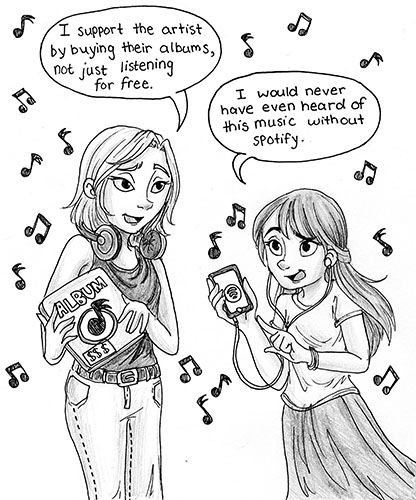Streaming services blamed for decline in music industry’s profits

Illustration by Jini John
October 2, 2015
In this technological-savvy era, there are many different ways of obtaining music, including streaming services like Spotify, media libraries like iTunes and buying physical copies like CDs and vinyls. However, according to forbes.com, digital sales of music have declined by 5.7 percent in the past year, and album sales by 8.4 percent. Some blame streaming services for this decline, while others believe streaming music is the future of the industry.
Pop star Taylor Swift brought this debate to a bigger stage in November 2014 when the singer took all her music off of the popular streaming service, Spotify. Swift explains why she decided to take her music off of the streaming service in an interview with Time Magazine.
“I’m always up for trying something,” Swift said. “And I tried [Spotify], and I didn’t like the way it felt. I think there should be an inherent value placed on art. I didn’t see that happening, perception-wise, when I put my music on Spotify.”
According to Swift, the reason behind the shrinking sales of albums is due to people’s inclination for streaming services.
Sophomore Julia Sarasin said she was shocked when Swift pulled her music from Spotify.
“I thought it was a little bit crazy, because she does have a lot of fans that will pay for her music,” Sarasin said. “[Because] she’s a famous artist, a lot of people want to hear her songs on Spotify.”
However, senior Sarah Jane Rubenstein agrees with Swift’s decisions and the reasoning behind it.
“I think that music has value,” Rubenstein said. “I think now people don’t treat it that way, but it’s an art, and if you look back in history, music was always treated as an art and people made a big deal out of it. Now with technology, people are treating it like something that they’re entitled to.”
According to Time Magazine, an artist with their music on Spotify makes between $0.006 to $0.0084 per stream, depending on whether or not the song is streamed by a free user or a Spotify premium user (premium users pay $9.99 a month). Currently, premium users only make up 26.67 percent of Spotify’s 75 million active listeners, according to spotify.com.
iTunes pays the average artist about 8 cents a song, according to The New York Times. However, due to the fact that Swift writes or co-writes most of her songs, Swift will gain around $3 for every album sold, whether physical or on iTunes. Swift needs thousands of streams to equate to the price of one album sold on iTunes. This, according to Swift, is the reason financially for why she took her music off of the streaming service.
However, many will argue that the exposure streaming services like Spotify or Pandora give to artists will, in the long run, be just as effective as a sale made now. Junior Jane Carpenter sees streaming services as an advantage for artists.
“I think artists are entitled to release their music to whoever they want, but I don’t think it’s wise to withhold music from streaming services,” Carpenter said. “Most of artists’ revenue nowadays is generated from concerts, and limiting fans’ access to the music probably means selling less tickets.”
In an unscientific Oracle-conducted survey of 171 students, 56.7 percent of students said they use some type of streaming service. Sophomore Ethan Sawyer follows this trend, saying that streaming services are the future of music sales.
“I think artists like Taylor Swift won’t be making as much money [with their music on] streaming services; however, it’s necessary for artists to join streaming services since that’s where music is headed,” Sawyer said.


